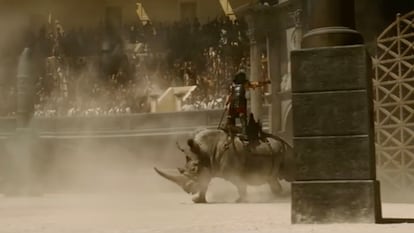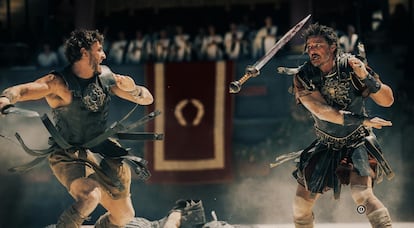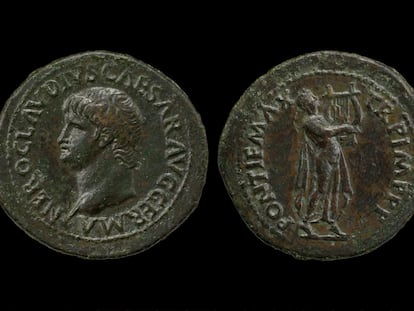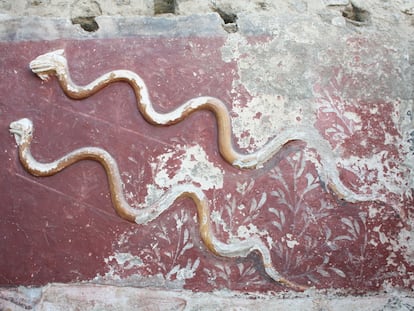‘Gladiator 2’: Rhinos in the arena demonstrated Rome’s power over the world
These animals, captured in either Africa or Asian, could often be seen in the Colosseum, fighting against bulls or being killed by Emperor Commodus


Roman emperors moved two things over thousands of miles just to demonstrate that nothing was impossible with their power: Egyptian obelisks, which weighed tons, and exotic animals as large as elephants and as ferocious as lions or tigers, which captured in Africa or India. In the first trailer for Gladiator 2 — which was released this week, although the film does not come out until November 22 — a rhinoceros is seen in the Colosseum. This was a fairly common animal in the violent Roman games held by emperors to entertain the people, but more importantly, to demonstrate Rome’s ability to dominate the world.
The Day Commodus Killed a Rhino is the title of Jerry Toner’s 2014 book, in which the Cambridge professor explains the keys to understanding the Roman games. The sequence in the trailer — which seems to be a replica of the battle in the first movie, in which Maximus leads a group of gladiators against a much more powerful rival — shows a gigantic rhinoceros entering the arena before a group of prisoners, logically frightened by the magnitude of the beast, which is being ridden by an armed combatant.
“The presence of a rhinoceros was a sure sign of the greatness of the games,” Toner writes in his book. He explains that Pompey the Great included a rhino at his games in the year 55 BC and that “the emperor Titus had brought a rhinoceros to the games with which he celebrated the inauguration of the Colosseum, in the year 80.” The animal, at first, remained paralyzed, but then it brutally charged at a bull, which it threw into the air to the applause of a stunned crowd. Augustus also included the animal in the games of the year 29, held in honor of Julius Caesar. But the most famous rhinoceros was the one brought by Commodus, the psychopathic emperor, obsessed with the Roman games, and the villain of Ridley Scott’s first Gladiator.
“Roman leaders seem to have had a thing about killing rare breeds,” Toner writes. “With skin up to almost two inches thick in places, a rhino is not an animal that is easy to kill even with a modern rifle. We can only imagine at how many arrows and spears, or how much assistance from others, it took before Commodus finally managed to fell the poor beast.”

If seeing a rhinoceros in a zoo, not to mention on in the wild, is unforgettable today, it is difficult to imagine the impression it must have made on the Roman public, even though it commonly appeared in mosaics. It was not an unknown animal, but it was something of a mythical creature. Martial, the Roman satirical poet of the first century of our era, dedicated the following verses of On the Spectacles to the species: “Shown along thy Arena’s floor, O Caesar, a rhinoceros afforded thee an unpromised fray. Oh, into what dreadful rage fired he with lowered head! How great was the bull to which a bull was as a dummy!”
Spanish researcher María Engracia Muñoz-Santos has published one of the most complete studies on this subject: Animals in Harena. Exotic Animals in Roman Games. “According to Pliny, animals with a horn, referring to rhinoceroses, ‘were frequently seen,’ so we can deduce that Asian specimens were quite often used in the games,” she writes.
However, the rhino that appears in Gladiator 2 is clearly African, given it has two horns — this is what distinguishes it from its Asian relatives. Muñoz-Santos points out that the first evidence of rhinos in Rome date back to the time of Domitian (70-96), the last of the members of the Flavian dynasty which was followed by the Antonines, the dynasty featured in Gladiator 2. Commodus was the last member of this dynasty. After the civil war known as the Year of the Four Emperors, the Severan dynasty came to power in 193. This dynasty included the emperors Geta and Caracalla, who will play an important role in Gladiator 2.

The challenge was not just in killing or handling a rhino in the games, but in capturing it at a time when tranquilizer darts did not exist. “Of all these artistic manifestations, the mosaics are the ones that perhaps offer us the most information about the phase to capture the animal,” writes Muñoz-Santos.
The animal’s capture likely began with a commission from someone powerful to organize a spectacle, and the hunters were typically a combination of natives and legionaries. “There is evidence that Roman soldiers also participated. It was probably part of a soldier’s duty or training,” Muñoz-Santos explains in her book.
Nets and different traps were probably used or, in the case of tigers and lions, puddles were filled with wine to get them drunk. For anyone who has seen Hatari! — Howard Hawks’ film about a group of adventurers who make a living trapping animals for a zoo — capturing a rhinoceros in ancient times, was somewhere between epic and suicidal.
Beyond the violence
All this effort had a meaning that went far beyond violence and spectacle. What’s more, not everyone enjoyed the brutality of the games: emperors like Marcus Aurelius and philosophers like Seneca had no hesitation about showing their displeasure at the viciousness of the games.
Mary Beard writes in her latest book, Emperor of Rome, that “the rarest, most notorious of the animals on display evoked the foreign and dangerous extremities of the natural world, which it was Rome’s destiny (as many of the audience would have seen it) to conquer or tame.”
She continues: “Whatever personal visceral pleasure the spectators may, or may not, have taken in the violence, the performances were also metaphors for the exercise of Roman power. Simply by sitting in their formal Roman dress and watching the show, the audience was experiencing the dominance of Rome and the Romans, and parading their part in it.”
Games, like everything in ancient Rome, were about power. And dominating a creature like a rhinoceros was the ultimate expression of what Rome could do with any people who crossed its path. Meanwhile, we will have to wait until November to see how the new battle in the Colosseum will end.
Sign up for our weekly newsletter to get more English-language news coverage from EL PAÍS USA Edition
Tu suscripción se está usando en otro dispositivo
¿Quieres añadir otro usuario a tu suscripción?
Si continúas leyendo en este dispositivo, no se podrá leer en el otro.
FlechaTu suscripción se está usando en otro dispositivo y solo puedes acceder a EL PAÍS desde un dispositivo a la vez.
Si quieres compartir tu cuenta, cambia tu suscripción a la modalidad Premium, así podrás añadir otro usuario. Cada uno accederá con su propia cuenta de email, lo que os permitirá personalizar vuestra experiencia en EL PAÍS.
¿Tienes una suscripción de empresa? Accede aquí para contratar más cuentas.
En el caso de no saber quién está usando tu cuenta, te recomendamos cambiar tu contraseña aquí.
Si decides continuar compartiendo tu cuenta, este mensaje se mostrará en tu dispositivo y en el de la otra persona que está usando tu cuenta de forma indefinida, afectando a tu experiencia de lectura. Puedes consultar aquí los términos y condiciones de la suscripción digital.
More information
Archived In
Últimas noticias
Tiger Woods turns 50: Will he continue playing on the PGA Tour or take a back seat?
The surreal journey of James Nnaji, the Barcelona youth player selected in the NBA Draft who ended up in the NCAA
Trump claims peace in Ukraine is near, but Moscow suggests otherwise
A survivor’s account of the Interoceanic Train accident: ‘We were scared because of the speed on the curve’
Most viewed
- Oona Chaplin: ‘I told James Cameron that I was living in a treehouse and starting a permaculture project with a friend’
- Reinhard Genzel, Nobel laureate in physics: ‘One-minute videos will never give you the truth’
- Sinaloa Cartel war is taking its toll on Los Chapitos
- Why the price of coffee has skyrocketed: from Brazilian plantations to specialty coffee houses
- Chevy Chase, the beloved comedian who was a monster off camera: ‘Not everyone hated him, just the people who’ve worked with him’










































